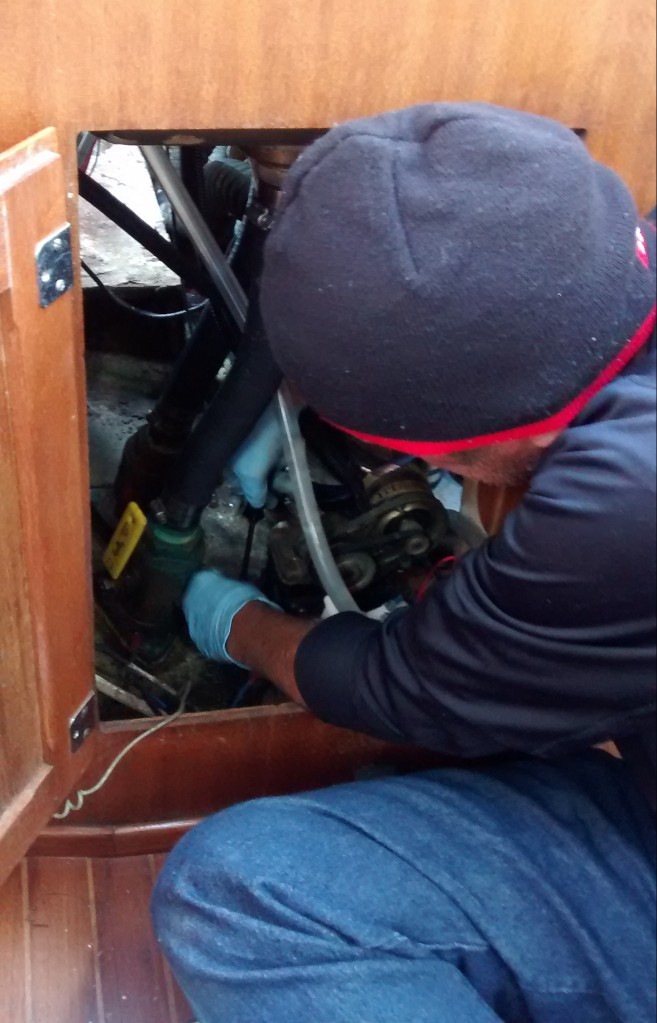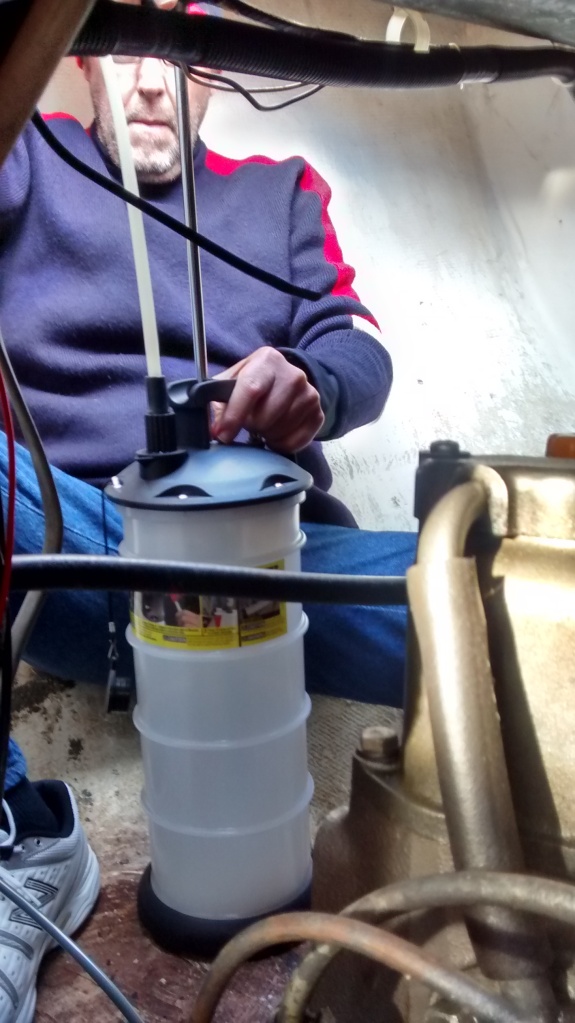As a native Southern Californian, I despise winter. I used to tolerate it, but these last two winters have pushed me over the edge. I’ve told Jeff that when we finally slip the lines and head out, I want our cruising grounds to be so warm that when it drops to 70 degrees I’m reaching for a sweater. Jeff, a native of Rochester, NY, doesn’t hate winter like I do but even he’s getting to the point where he’s had enough. Until we leave, however, we need to deal with Mother Nature’s annual months-long interruption of lovely warm days and nights.
With low temperatures this past weekend expected to drop down to the high 20’s, it was no longer possible to deny reality: cold weather is coming soon. It was time to winterize. For us, this meant that we needed to change Pegu Club’s oil and run antifreeze through the engine, top off the fuel tank with diesel and add biocide, and empty the water tanks. Keeping the hot water heater and pressure water system would have added a few steps, but since we didn’t want those features this was also going to be the weekend to get rid of them.
On paper our list looked pretty simple. The only catch was that we’ve never dealt with a diesel engine before. Pegu Club has a 1977 single-cylinder Yanmar SB 12 that we’ve named “Thumper”, and online documentation is slim. I was able to find a free operator’s manual online which was a start, and we paid $40+ dollars online to the only source I could find for a service manual. We figured between the two manuals we’d be o.k. What we didn’t expect when the service manual arrived was for it to be lousy photocopies with black and white pictures that resembled a Rorschach test. Can you say rip off? We were not pleased.
We headed down to Shenny on Saturday hoping that we could piece together the information that we needed with the one and one-quarter manuals that we now owned (honestly, the service manual barely rated a 1/4 manual) and a copy of Nigel Calder’s Diesel Engines book. We were ready to get to work.
Prior to the weekend, staring at the engine was akin to looking at a page from a book written in Russian. You know you’re looking at words, but damned if you know what it says. Well, we knew we were looking at an engine, but it really just looked like a hunk of metal. So we decided to start with something we knew we could do – remove the hot water heater and the pressure water system.
Both items came out very easily. It helped that the hot water heater wasn’t connected to the engine because it ran solely from shore power. Jeff drained the water out of the six-gallon heater to lighten the load before tossing it over the side of the boat. Although the water smelled like sulfur, it was no comparison to the smell of the holding tank. I knew when we finished removing the head that nothing would be as bad as that project! Sulfur? Ha! We laugh at the smell of sulfur!
After we removed the pressure water motor, we took out the related hoses and pipes, leaving us with a foot pump for the galley sink. The sink in the head only had pressure water, but we will be installing a foot pump (if there’s room) or a hand pump in it before spring.

We also took a bit of time removing some wiring-to-nowhere. We have several electrical wires that obviously powered something, but when prior owners removed those items they simply snipped the wire, leaving it behind for the next owner to deal with. I discovered with Little Bristol that I have a weird affinity for tracing wires. It’s like a little mystery. Following the wire through nooks and crannies; jiggling it when I lose sight of it and listening for where it tap-taps to find it again. For some reason it’s quite satisfying. Anyway, although we didn’t pull the wires completely out (that will wait for another weekend), we know that we’re freeing up two spots on our 12 volt panel for our future chart plotter and Engel fridge, so that’s rather convenient.
Once the hot water heater and the pressure water motor was out, the access to the engine went from very good to astonishingly good. One of the unexpected benefits of our Bristol 29.9 has been the engine access. We had read many complaints from people with different boat models about how difficult it was to get to their boat’s engine. The Bristol 29.9 does not have that problem. We can access the front of the engine behind the removable cabin steps, and the side with the important items is completely open for work by climbing into the starboard lazarette. It’s so large that Jeff, at 6’4″, has no problem getting completely inside.

We stared at the engine for a while, consulted our 1 & 1/4 manuals, traced some hoses, and decided to dive in. We knew that if we got nothing else done that day, we had to run the antifreeze through the engine. Thumper is cooled with raw water, meaning that as it runs the raw water intake hose sucks in ocean water which gets circulated through the engine and out the exhaust. Since Pegu Club was now sitting on land, we had read that we could simply put the hose in a 5 gallon bucket filled with anti-freeze to get it circulated through the engine.
Before we used the anti-freeze, we wanted to run fresh water through the engine. After disconnecting the raw water intake hose from the seacock, we stuck it in a bucket that we had filled with water. We had attached a hose to the faucet near our boat, and the hose had an on/off sprayer ready to replenish the bucket as the engine sucked in the water. We were both more than a bit nervous about doing this, unsure that it would really work. Jeff was in the main cabin with the bucket and hose, and I was in charge of starting the engine and making sure that water came out of the exhaust. We agreed that if I didn’t see water start to come out in ten seconds, I would shut the engine off right away.
We held our breaths and turned the key. Nothing happened. Doh! For a minute Jeff was worried that one of the wires that he had removed had left an open circuit, preventing the starter from working. I was thinking, “We can’t start the engine and it’s going to be 28 degrees tonight! How are we going to get the antifreeze in it?” Yes, I knew that the engine itself wouldn’t drop to 28 degrees that night, but that wasn’t the point.
Jeff switched the battery selector, and we tried again. Thumper roared to life, and water came out in under ten seconds. Yes! After letting the water run for several minutes, we turned off the engine and filled the bucket with antifreeze. We started Thumper again and less than two gallons later, pink antifreeze started coming out of the exhaust. Hooray! We did it!
After basking in the glow of our success for a few minutes, it was time to figure out how to change the oil. We had wanted to do this after the antifreeze step so that the oil would warm up, making it easier to remove. This turned out to be a relatively easy process, with the exception of the fact that we couldn’t find the oil filter. We knew from internet research that the SB12 doesn’t have a replaceable oil filter. There is a permanent filter with a handle that turns from side to side to get the debris out, but we couldn’t match up a Rorschach blob with anything similar-looking on Thumper. So we decided to leave putting the new oil in until the next day, hoping we could get some help from one of the sailing forums.
The next morning I was trying to find a picture of the oil filter online. I decided to look up the part number, hoping that there would be an accompanying picture. I found the part number, but no picture. Then Jeff suggested that I Google the part number and “image” – bingo!

Back at Shenny it only took a minute to find the oil filter. Funny how quickly you can find something when you know what you’re looking for! Jeff cleaned the filter, added oil into the crank case and the clutch case, and we were all set.

All that remained was making sure the water tanks were empty, topping off the fuel tank with diesel, and adding the biocide – easy peasy. And just like that, Pegu Club was winterized.
It was nice to have a change of pace from all of the rebedding we’ve been doing over the past few weeks. We debated finishing the last cleat, but the idea of holding onto a chunk of metal when it was in the mid-40’s outside was less than appealing. Next weekend’s forecast looks a bit warmer, so the plan is to rebed the last cleat and finish bedding the bow and stern pulpits. If time permits we’ll also bring the Nature’s Head onboard so we can install it sometime over the winter.
Bit by bit, we’re getting there!


Hi, are you making notes for next year? Your posts would even work if you print them. Isn’t it wonderful when things go smoothly? You both will know your Pegu Club inside and out. I am glad you have something that you both love to work on together. Love you both, Nikki
LikeLike
Hi Nikki, Yes, we’re definitely taking notes (and pictures) for next year. I was saying the same thing to Jeff – we’ll know every square inch of her by the time we leave. 🙂 Love, Kimberly
LikeLike
My wife Denise and I are the proud owners of Bristol 29.9 Hull #1 One Day. We stumbled across your blog and love it! For the Yanmar SB12 the most helpful documentation is the Parts Catalog. It has clear, detailed exploded diagrams of everyhing in the engine with a table with the part numbers. You can get it at Toad Marine Supply: Yanmar, part number : Y00R0922, description : Yanmar SB8 & SB12, Parts Catalog, total price : 78.35
It’s expensive but well worth the money.
Thanks,
Mark and Denise McGovern
LikeLike
Thanks, Mark! I’m glad you and your wife are enjoying the blog. We’ve since managed to get our hands on a parts catalogue and it’s extremely helpful. Denise and I have commented on each other’s posts on Women Who Sail. How cool to own hull #1 – we’re only 16 behind you. 🙂 I’d love to keep in touch with fellow B29.9 owners!
Take care, Kimberly
LikeLike
Glad to hear that. I’m an engineer and work in the automotive field and I couldn’t imagine working on the engine without that Parts Catalog! It is pretty cool to have hull #1. It was part of the inspiration for the name “One Day”. Denise told me that she found you on Women Who Sail group. Feel free to contact Denise or I about anything regarding the B29.9 and we’ll do what we can to help!
LikeLiked by 1 person